National Wildlife Day, which was yesterday, was actually a pretty nice day for February, nicer than February actually deserves because it’s in winter and also spelled stupidly. And since I had a photo outing scheduled, I succeeded in getting plenty of photos of wildlife, if by ‘wildlife’ you mean ‘birds,’ with one exception. A moderate variety of birds too, at least for stupidly-spelled months.
We’ll begin with the faint tapping noise that I heard while passing a dead tree a short ways into the water (this, again, being Jordan Lake, but there were good reasons for that.) I was out there with Mr Bugg, and we paused and examined the tree carefully, not seeing anything, but my attention was on a small opening from a rotted branch, and sure enough, someone appeared therein after a minute.

This is a brown-headed nuthatch (Sitta pusilla) that was working on its nest, examining us curiously because it did not specifically recall us being out there when it entered. It’s funny; I’m almost positive that every time I’ve photographed this species, it’s been in exactly the same way: hearing them excavating within the trunk and waiting for their appearance. Once again, I’ll stress that paying attention to odd sounds can help a lot.
We’re not going in chronological order, and I apologize for pulling a Tarantino here, but it works better this way. So we’ll have a quick peek at a flotilla that was spotted from the higher vantage of the causeway, then photographed from a promontory because the view was better, but quite some distance out onto the lake (at least a half-kilometer) was a dark stain that turned out to be birds. Lots.
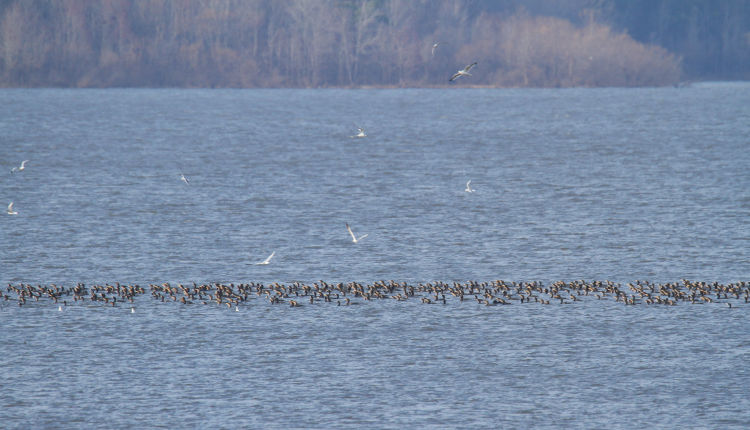
This doesn’t do it justice, since this is less than a third the breadth of the flock, clearly hundreds of birds. I had to zoom in on the image more than this to identify them, though:
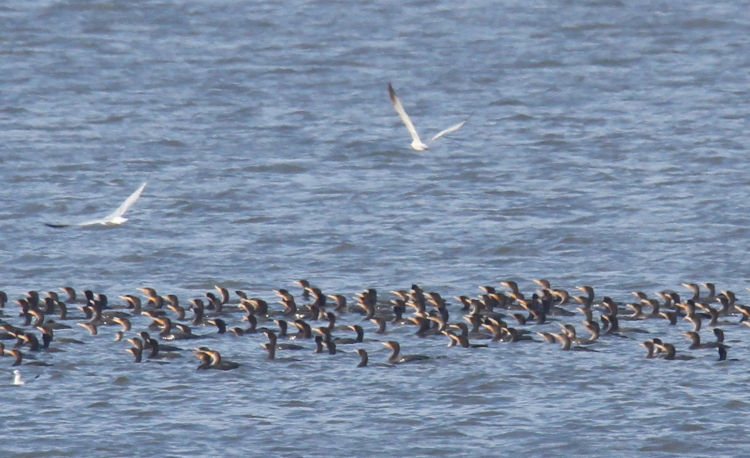
That’s enough to know that they’re double-crested cormorants (Nannopterum auritum,) and there’s something almost unsettling about them all facing the same way. However, this was into the wind and so it probably helped them maintain position and not drift too much. I’m pretty sure Mecca is the other direction, at least.
There are seagulls in that image too, but way too distant to determine what species – I always assume herring gull, since that’s the most prevalent species this far inland, but at another point, a few gulls passed close enough for some detail shots, and this one, at least, was clearly not a herring gull.
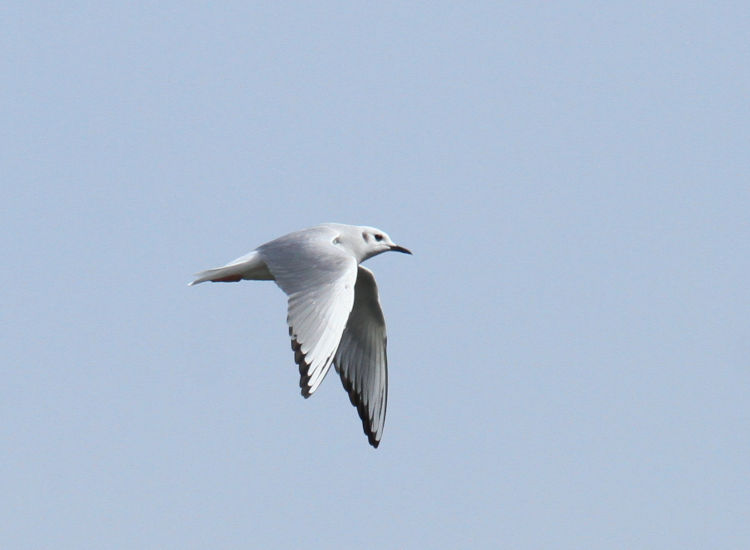
Near as I can tell, this is a little gull (no, seriously, that’s the common name, otherwise Larus minutus,) but it’s hard to be sure. Partially, because alone in the sky, it was difficult to determine the size, and partially because we’re on the border of mating season when nearly all birds adopt different plumage, so we might be in transition here. But the overall coloration, with the dark bill, red legs (visible more in other frames) and ‘ear’ spot all fit, anyway. And it came close enough for more of a portrait.

I don’t bother with the gulls too often, especially because there’s so few in the area that they don’t get competitive or show much behavior, but I’m okay with this portrait and pose.
On another section of the lake, a great blue heron (Ardea herodias herodias) was foraging in a small pool that is primarily replenished when the lake levels rise, though in summer it often goes stagnant.
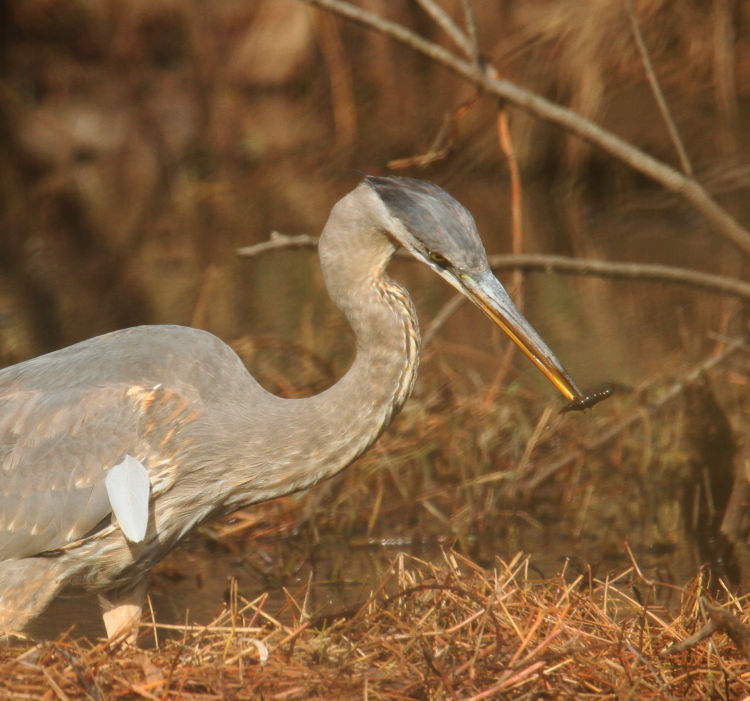
There were many many small branches in the way, and as I could see the heron had captured a small meal, I was firing off frames and not maneuvering for a better vantage; this meant that the sequence of images all suffer from defocused branches reducing sharpness and contrast (boosted slightly here.) But I could at least make out afterward that what it captured was a crayfish, our one bird exception, which was juggled for a minute before finally going down the hatch. I can find no evidence of pincers, however, and I’m not sure if it was found that way or the heron managed to break them off before attempting to swallow it – this is the first I’ve seen one with a crustacean, I think.
Once the bird finished its meal and started further foraging, I shifted around for a clearer view. Better?

Actually, you can still see some haze in the lower right corner from a branch, but the heron itself is unobscured now.
And from here on in, we deal with just one species: bald eagles (Haliaeetus leucocephalus.) Which is largely what we were after in the first place, though neither of us will pass up anything else that appears. But we’ve been watching the presence of the eagles at Jordan Lake steadily increasing, quite heartening, and this means more chances for cool behavioral shots – though not too many on this day. But we’re getting to that.
We had driven back and forth between two access areas, and in the parking lot of the second, we watched a juvenile cruise low overhead, providing the closest opportunity of the day – well, for the eagles at least. The nuthatch has everyone else beat by a mile.
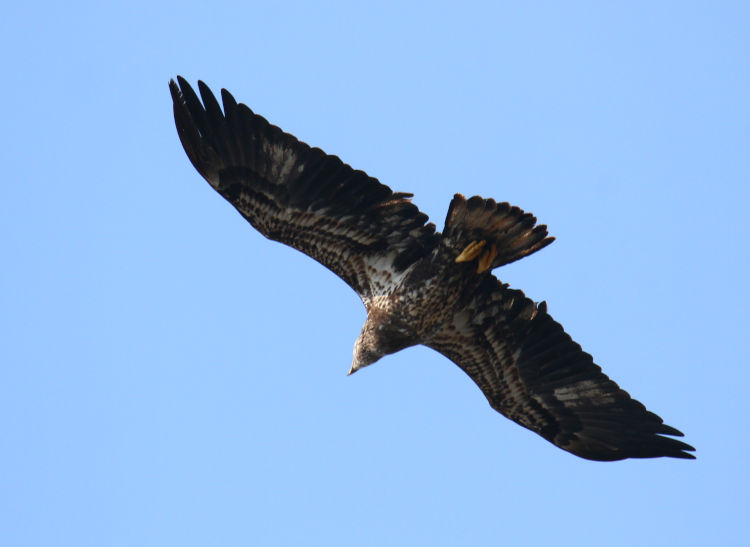
I initially pegged this as a second year juvenile, but it might be a third instead; the easiest way to tell is the dark stripe back from the eye on an otherwise lighter face, but this one never gave me that vantage, even after finding it a little later on (probably, anyway) cruising around with an adult.

It was overall a pretty good day for soaring, the sun having warmed things enough for some thermals, but also some stiff winds across the water – in places, I gave up on keeping my hat on and just let it hang off the back of my head from the chin strap.
But it was in the other area that we had the most luck. Upon arriving, we met a birder there with a spotting scope, who admitted to not having much luck despite being told that someone had spotted pelicans there that morning. This is quite surprising, since I’ve never seen pelicans on Jordan Lake or indeed anywhere but coastally, and we certainly saw none yesterday. But after about 30 minutes or so of nothing but vultures, seagulls, and cormorants, a pair of adult eagles showed in the distance, and eventually flew close enough for some nicer frames.

This one I found a little curious in that it has matching broken primary flight feathers, number five on either side. Now, birds typically molt by losing two flight feathers simultaneously, which keeps them balanced, but those drop out – they don’t break off. A cool coincidence though.
The pair would wheel around and disappear behind trees, and later on we’d see two more – likely that same pair, but there was no way to be sure. This one, however, posed better with the light and angle.

Soon after this, the pair split off; one went straight off and took a position in a dead tree near the osprey nest, while the other vanished over the trees more behind us. And then it got interesting.
We were maneuvering closer around the lake edge, which shifted the dead tree in relation to the trees behind it, providing better views of the perched eagle against the sky. And then, it started calling, and I didn’t realize it at the time (the viewfinder image being way smaller than this,) but I caught a nice frame of the eagle with its head thrown way back.

The reason became clear soon enough, as the other eagle appeared against the trees (meaning quite low,) closing in with a fish in its talons, obviously headed for the perched one. I snagged a decent frame as it appeared against the sky briefly.

Its approach took it wide around the perched one, who left its perch and the two of them converged on the osprey nest nearby, the same one that I saw two eagles checking out a few weeks before – there’s no way to prove that it’s the same two, but I’m comfortable with that supposition anyway.
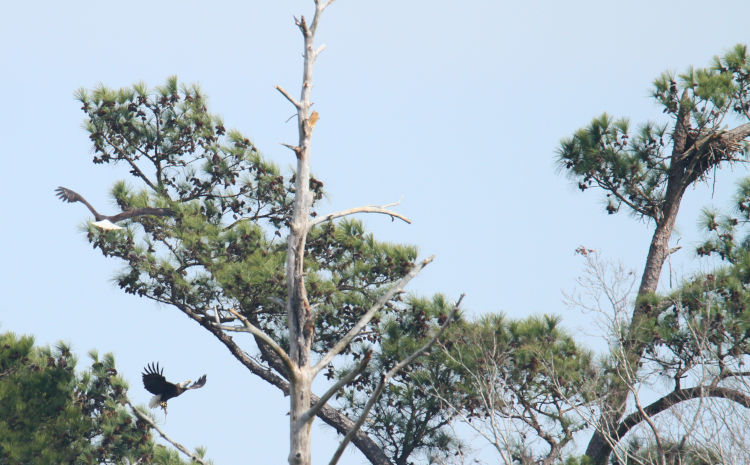
You can see the nest over in the right corner here, while the one in the dead tree has left its perch (back to us) as the new arrival, more distant, is closing in with the fish. We’ll got for a tighter crop.

The distance compression through the long lens destroys the depth, but the one from the dead tree is notably closer than the background tree holding the nest – we can place the dead tree in many positions in relation to the nest itself just by following the curve of the lakeshore around. Though it’s hard to do as the action is occurring. One of these days, I’ll take a compass and some notes and triangulate the positions of the tree and nest, just as an exercise.
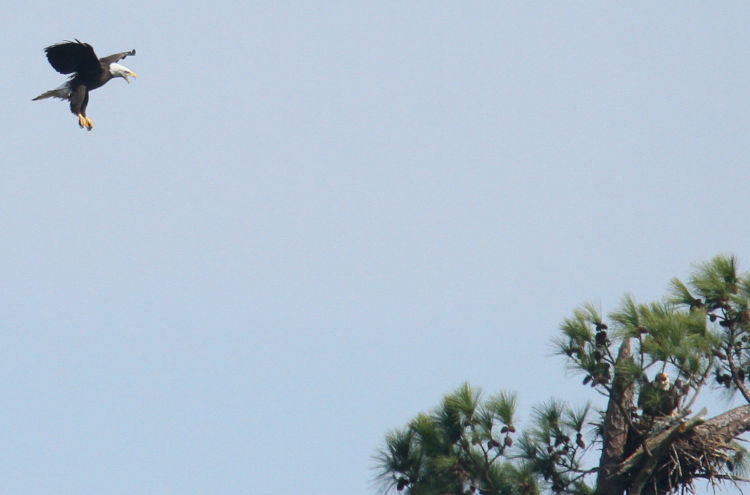
As the new arrival landed o the nest itself with the food, the one from the dead tree closed in, calling exuberantly in that namby-pamby, bad bearings way that eagles communicate. But this raises all sorts of questions, because they’re obviously ‘together,’ though what exactly that means is unclear. Both over four years old, so old enough to mate. Eagles often take over old osprey nests, but the size disparity between the species means that the eagles invariably build much bigger nests atop, and there’s been no sign of this happening, while it’s starting to get late in the season for this to begin. But one was clearly waiting for the other to bring food, and I’m not up on my eagle information enough to know if this is courting behavior. So, what’s going to happen?
Whatever else, this is at least giving a lot of promise to having a decent vantage for plenty more images as the season progresses – not to mention that this nest can be approached from another direction, seen closer from underneath, though we’re purposely avoiding this until we’re pretty sure that someone is on the nest with eggs, to avoid spooking them away from it before this occurs. If it occurs.
Both left the nest after the meal was consumed, but were seen later the same day returning to the nest itself, as well as perching together in that same dead tree. So, you know, not a bad way to spend the holiday, and certainly continuing the promise from a few weeks back. We’ll see how lucky we get.

















































